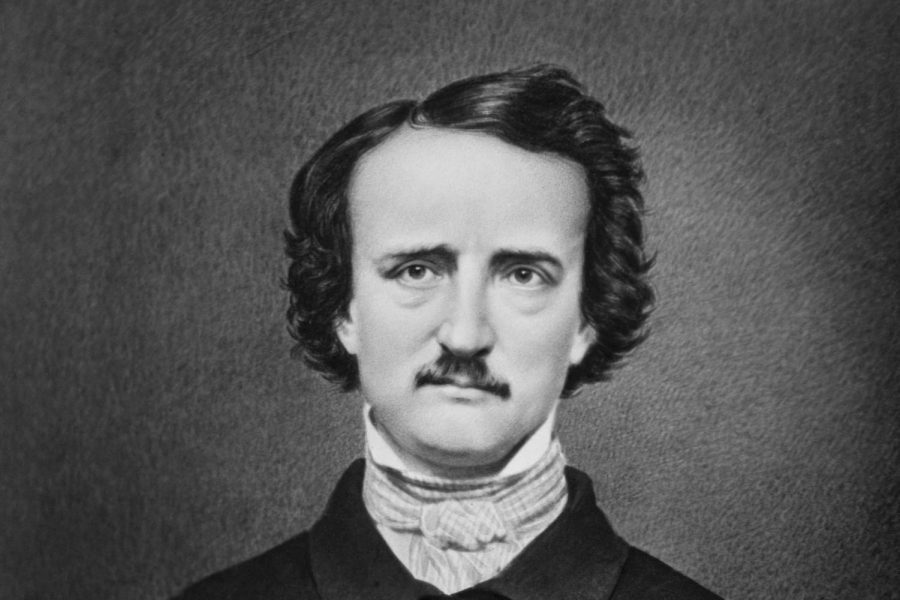Poet’s Pen: Edgar Allan Poe
October 1, 2020
Once upon a Halloween dreary, while I wandered, trick-or-treaty,
Over many a spooky, scary volume of forgotten poems —
What hasn’t been said already about Edgar Allan Poe? An indisputable literary mastermind, Poe is an inspiration to all, from English teachers at Halloween-time to our own Baltimore Ravens. But what was it that made this poet? What was the influence of this iconic writer of poet and prose? What ooky-spooky work of his will be featured at the end of this article? Find out…
Your elementary school teachers lied to you: Poe is not from Baltimore. Rather, he was born in Boston, on a chilly January day in 1809. His parents, both actors, died before he was even three, and he was raised by John and Frances Allan. Riding on the coattails of his successful tobacco-exporting father, Poe attended the most prestigious boarding schools, where he was a top student; college, however, did not proceed so swimmingly. He had hardly spent a year at the University of Virginia before his father cut Poe off because of his gambling debts. These habits would not improve with time, and neither would his quickly-crumbling relationship with Allan. He then spent a bit of time in the military, publishing some minimally-received collections of poems, namely “Tamerlane, and Other Poems” and “Al Aaraaf, Tamerlane, and Minor Poems,” but he was soon booted from the U.S. Military Academy as well for lack of financial support.
Finally, at the ripe old age of 20, Poe moved to Baltimore to live with his aunt, Maria Clemm. He began to sell short stories to magazines, and at 27 married his 13-year-old cousin, Virginia, which we will hurriedly gloss over. He did not stay long in the land of Old Bay; Poe’s career had him city-hopping like a poetic frog between Richmond, New York, and Philadelphia. He began editing for literary journals such as the Southern Literary Messenger and the Gentleman’s Magazine, among several others, and it was during this period that he published some of his most iconic works: “The Raven,” “The Tell-Tale Heart,” and “The Fall of the House of Usher,” to name a few. By this point Poe had truly begun to make a name for himself, though pitted against his rising fame and moderate monetary success (the early 19th century was not financially kind to writers) were his looming depression and alcoholism, which only worsened after Virginia’s death to tuberculosis in 1847. Poe would die two years later on Oct. 3, under mysterious circumstances (later evidence suggests it was possibly rabies).
Though his writing career was short, it spurred influence on an international scope. A forerunner of the “art for art’s sake” movement and considered the “architect” of the modern short story, he was lauded by French Symbolists and critics worldwide for his innovative approach to the art of the pen. Many writers before him took an autobiographical approach and believed that their work was a part of them, resulting in products that were, put plainly, unimaginative. But while his predecessors regarded their works as their children, Poe treated each of his like a sculpture: each product intricately unique. He was unafraid to explore the most frightening possibilities of fiction, bringing characters and their fears to vivid life with imagery you can nearly touch. This intimate and sincere approach, combined with the allure of dark romanticism and Poe’s unmatched way with manipulating language, resulted in a vast library of iconic poems and prose that enrapture readers to this day.
In this spookiest month of the year, it is only fitting to select a Poe poem to feature: “The Haunted Palace” describes the decline of a grandiose and luxurious palace into a hollow shell of spectres.
In the greenest of our valleys
By good angels tenated,
Once a fair and stately palace —
Radiant palace — reared its head.
In the monarch Thought’s dominion —
It stood there!
Never seraph spread a pinion
Over fabric half so fair.
Banners yellow, glorious, golden,
On its roof did float and flow,
(This — all this — was in the olden
Time long ago,)
And every gentle air that dallied,
In that sweet day,
Along the ramparts plumed and pallid,
A winged odour went away.
Wanderers in that happy valley,
Through two luminous windows, saw
Spirits moving musically,
To a lute’s well-tuned law,
Round about a throne where, sitting
(Porphyrogene)
In state his glory well befitting,
The ruler of the realm was seen.
And all with pearl and ruby glowing
Was the fair palace door,
Through which came flowing, flowing, flowing,
And sparkling evermore,
A troop of Echoes, whose sweet duty
Was but to sing,
In voices of surpassing beauty,
The wit and wisdom of their king.
But evil things, in robes of sorrow,
Assailed the monarch’s high estate.
(Ah, let us mourn! — for never sorrow
Shall dawn upon him desolate!)
And round about his home the glory
That blushed and bloomed,
Is but a dim-remembered story
Of the old time entombed.
And travellers, now, within that valley,
Through the red-litten windows see
Vast forms, that move fantastically
To a discordant melody,
While, lie a ghastly rapid river,
Through the pale door
A hideous throng rush out forever
And laugh — but smile no more.
In an essay entitled “Edgar Poe’s Tradition,” Herbert Marshall McLuhan wrote of Poe: “While the New England dons primly turned the pages of Plato and Buddha beside a tea-cozy, and while Browning and Tennyson were creating a parochial fog for the English mind to relax in, Poe never lost contact with the terrible pathos of his time. Coevally with Baudelaire, and long before Conrad and Eliot, he explored the heart of darkness.” Poe teaches us to embrace the dark, and what beauty can be born of our fears. What more is there to say of the legend, Edgar Allan?
Quoth the author, “Nevermore.”
Poetic excerpts and biography taken from Poets.org.

